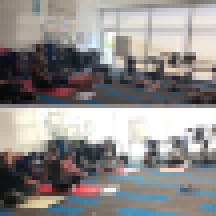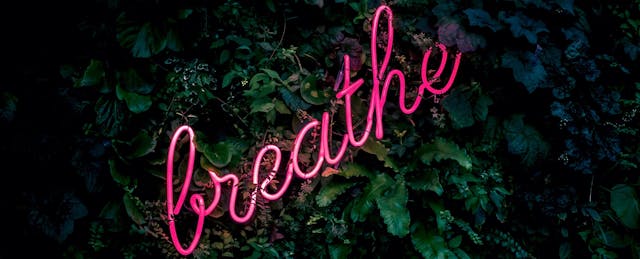Sitting on my mat, in a room full of seventh graders, I said to myself, “Something is wrong.” It was too quiet, too calm. As I led the group through our opening rounds of sun salutations, I was unable to shake the thought, but when I opened my eyes it suddenly occurred to me that the room was silent because everyone was engaged in the movement and breathwork that I was leading.
I was six weeks into implementing a pilot program with my students using Youth Elevate, a yoga, mindfulness and social-emotional curriculum for adolescents. We finally had enough yoga mats for everyone in the class and the kids were getting into the rhythm and routine of being guided through yoga and meditation on a weekly basis.
The work we had been doing was kicking in, and I was eager to get a better sense of how it was affecting my students. I wondered what the results of the Youth Elevate pre-assessment would show, and whether they would provide an accurate measure of the impact of our yoga, meditation and wellness practices on student growth. I knew that if I wanted to grow this program to reach my entire school community, I’d need to present evidence that it was working.
From Focus Student to Small Group Pilot
As a special education teacher at The Bayshore School in Daly City, Calif., collecting evidence is a big part of my job. I work with students who bring a diverse range of abilities, perspectives and experiences to the classroom. Some of them struggle with attention, have difficulty completing work independently or have a tough time remaining engaged for extended periods of time. Each year, my students grow in countless ways, but their progress isn’t always reflected through traditional assessment, so finding creative ways to capture growth is inherent to my role.
The seventh grade pilot grew out of my work with a specific student last year, Brooke. I met her when she was in fifth grade. It was my seventh year teaching, so I had worked with challenging students before, but she was different. She had trouble focusing, completed minimal work and was resistant. I constantly asked my administrators to help me figure out the best way to support her, but to no avail. My bag of tricks wasn’t working.
When Brooke entered sixth grade, her behaviors from the previous year showed up almost immediately and were seemingly worse. I knew I needed to do something different, but I wasn’t sure what. As I observed her throughout the day across different learning environments, I saw aspects of my middle school self in her—self-conscious, loud, attention-seeking and angry. Then I had an epiphany.
I started doing yoga when I was 22. Now, at 33, I often say yoga saved me. It has allowed me to focus for longer periods of time, use deep breathing techniques to help me with a variety of emotions, release my anger in a safe and healthy way and be comfortable with who I am.
I called Brooke, her mother and my administrators into a meeting and proposed the idea of practicing yoga with Brooke. Everyone was on board and I got permission to do yoga with her once a week in place of her regular PE class.
When we started our yoga experiment, she was excited. I was very honest about the fact that I had no idea what I was doing—I knew how to practice yoga, but teaching it was totally different. Most days, we watched videos on YouTube and practiced together. Most of the time she maintained her excitement and was engaged, but sometimes she wanted nothing to do with yoga and sat on the mat, refusing to practice at all. Her progress fluctuated, but a clear outcome was that our relationship grew stronger and we developed a mutual respect for each other. She grew more willing to complete small amounts of work with me and was open to hearing why she needed to transfer those skills to her work with other teachers.
Toward the end of her sixth grade year, I let Brooke know that the progress I had seen in her inspired me to seek out ways to improve my own practice as a yoga teacher in an effort to bring some of the work we had done together to other students in the school. Through my research, I learned about Youth Elevate and attended a week-long workshop over the summer. I was excited to dive into the curriculum, which was specifically designed for adolescents and covered thematic units such as:
- Mindfulness and self-awareness
- Commitment to truth
- Tools to deal with anxiety, stress and frustration
- Dealing with anger and emotions
- Bullying and cyber-bullying
- Electronic distraction and internet safety
- Self-care, self-love, nutrition
The workshop helped me develop the skills I needed to be a stronger yoga teacher, and the curriculum, written by a yoga teacher and mother of two, empowered me to bring a stronger yoga teaching practice to my focus student and her classmates.

Alternative Pathways to Progress
After completing the workshop, I told practically every teacher I knew about it. One teacher took me up on my offer to pilot the curriculum in her classroom, which coincidentally was Brooke’s seventh grade homeroom. Since our school has prioritized social-emotional growth this school year, the timing was perfect.
When piloting a new curriculum, it is important to show impact. With Brooke, I was able to reflect growth through anecdotal narratives and progress towards IEP goals. With an entire class, including students with and without IEPs, I would need to find an alternative approach to gauge growth. The Youth Elevate curriculum includes pre- and post- program assessments that measure self-esteem, stress and emotional regulation, so I decided to start there.
Not surprisingly, on our first pre-assessment, 60 percent of students responded that they sometimes feel stress each week and 30 percent reported that they almost always feel stress. In our current climate, this information did not surprise me. What did surprise me, however, was the fact that so many students had trouble identifying things they could do to reduce stress. As we entered the first week of the Youth Elevate pilot, my goal was to create space for kids to take time for themselves and release stress each week.
Scaling What’s Working
We have not yet completed our first round of the pilot. But teachers have already noticed improvements among this group of young people. My partner teacher, who has known these students for longer than I have, reports that they are calmer and more independent than they have been in previous years.
As I wrap up this first round of the pilot, I’m eager to collect data from the post-assessment and compare it to the pre-assessment responses. I’m also planning to collect narratives from all of the teachers who work with this group of students, to help me understand if and how students are applying what they’re learning from our work together into other learning environments. To guide the narratives, I plan to send a Google form with a series of questions that prompt teachers to describe any changes they have noticed at the class-level and at the level of individual students.
Over the course of the year I’ll be rolling out the pilot first to an additional class and then making it available to all students in grades six through eight as an elective. In June, I’ll share the data with my administrators for consideration in scaling this curriculum to our larger school community.
I am so proud of the dedication Brooke has demonstrated and how far she has come. My hope is that the evidence I’m able to collect about the impact of wellness practices on student growth will be compelling so that we can bring these practices to even more of her peers.


